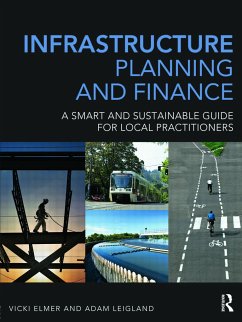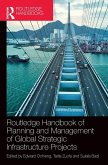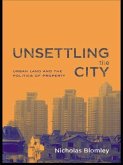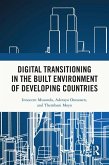- Gebundenes Buch
- Merkliste
- Auf die Merkliste
- Bewerten Bewerten
- Teilen
- Produkt teilen
- Produkterinnerung
- Produkterinnerung
Infrastucture Planning and Finance provides a non-technical overview of the engineering, planning and financing aspects of local level infrastructure for planners, engineers and other local officials who need to work with specialized professionals. It also gives basic "how to do it" information along with a brief overview of the larger policy and technical issues for each field.
Andere Kunden interessierten sich auch für
![Partnership Agencies in British Urban Policy Partnership Agencies in British Urban Policy]() Nick BaileyPartnership Agencies in British Urban Policy44,99 €
Nick BaileyPartnership Agencies in British Urban Policy44,99 €![Routledge Handbook of Planning and Management of Global Strategic Infrastructure Projects Routledge Handbook of Planning and Management of Global Strategic Infrastructure Projects]() Routledge Handbook of Planning and Management of Global Strategic Infrastructure Projects190,99 €
Routledge Handbook of Planning and Management of Global Strategic Infrastructure Projects190,99 €![Introduction to Modern Infrastructure Construction Introduction to Modern Infrastructure Construction]() George WangIntroduction to Modern Infrastructure Construction140,99 €
George WangIntroduction to Modern Infrastructure Construction140,99 €![U.S. Traffic Calming Manual U.S. Traffic Calming Manual]() Reid EwingU.S. Traffic Calming Manual172,99 €
Reid EwingU.S. Traffic Calming Manual172,99 €![Unsettling the City Unsettling the City]() Nicholas BlomleyUnsettling the City210,99 €
Nicholas BlomleyUnsettling the City210,99 €![Adapting Buildings for Changing Uses Adapting Buildings for Changing Uses]() David KincaidAdapting Buildings for Changing Uses187,99 €
David KincaidAdapting Buildings for Changing Uses187,99 €![Digital Transitioning in the Built Environment of Developing Countries Digital Transitioning in the Built Environment of Developing Countries]() Innocent MusondaDigital Transitioning in the Built Environment of Developing Countries219,99 €
Innocent MusondaDigital Transitioning in the Built Environment of Developing Countries219,99 €-
-
-
Infrastucture Planning and Finance provides a non-technical overview of the engineering, planning and financing aspects of local level infrastructure for planners, engineers and other local officials who need to work with specialized professionals. It also gives basic "how to do it" information along with a brief overview of the larger policy and technical issues for each field.
Produktdetails
- Produktdetails
- Verlag: Taylor & Francis
- Seitenzahl: 768
- Erscheinungstermin: 10. Dezember 2013
- Englisch
- Abmessung: 279mm x 221mm x 33mm
- Gewicht: 2313g
- ISBN-13: 9780415693189
- ISBN-10: 0415693187
- Artikelnr.: 34563001
- Herstellerkennzeichnung
- Libri GmbH
- Europaallee 1
- 36244 Bad Hersfeld
- gpsr@libri.de
- Verlag: Taylor & Francis
- Seitenzahl: 768
- Erscheinungstermin: 10. Dezember 2013
- Englisch
- Abmessung: 279mm x 221mm x 33mm
- Gewicht: 2313g
- ISBN-13: 9780415693189
- ISBN-10: 0415693187
- Artikelnr.: 34563001
- Herstellerkennzeichnung
- Libri GmbH
- Europaallee 1
- 36244 Bad Hersfeld
- gpsr@libri.de
Vicki Elmer is currently the Director of the Oregon Leadership in Sustainability (OLIS) graduate program at the University of Oregon where she teaches about sustainability and the urban environment. Before that she taught at UC/Berkeley's Department of City and Regional Planning for ten years. Dr. Elmer was also a planning director and public works director in the City of Berkeley, and City Manager in Eugene, Oregon and was the head of research at HUD's San Francisco office. Elmer's current research is on the intersection of compact urban design, water recycling and the water-energy-waste nexus. She is on the International Water Association's Cities of the Future Committee and the Water Environmental Research Foundation's committee on sustainable wastewater management. Her B.A. is from the University of Michigan (1964), MS: Columbia University (1970) PhD: University of California (1991). Adam Leigland is currently the Director of Public Works for Santa Fe County, New Mexico, where he is responsible for the provision, operation, and maintenance of roads and trails, water and sewer service, solid waste management, public facilities, and parks and open space. Prior to that, he was the Deputy Director of Public Works for a NATO air base in northern Italy, a senior transportation planner at the San Francisco County (California) Transportation Authority, and a civil engineering officer in the U.S. Air Force with service all over the world. He holds a B.S in civil engineering from the University of Notre Dame, and an M.S. in civil engineering and an M.C.P. in city planning, both from the University of California, Berkeley. He is a registered professional engineer in New Mexico, California, and Arizona, and a member of the American Institute of Certified Planners.
Part 1: Introducing Infrastructure 1. Infrastructure and Today's Challenges
2. Emergence of Infrastructure in the United States 3. Social and Economic
Underpinnings of the Demand for Infrastructure 4. Institutions of
Infrastructure: The Providers Part 2: Planning and Developing
Infrastructure-Rules, Responsibilities, and Practices 5. The Planning and
Delivery System 6. Comprehensive Planning for Infrastructure 7.
Infrastructure and Facilities Planning 8. Development Rules and
Infrastructure 9. Capital Improvement Plan, the Budget, and Strategic
Planning 10. Life Cycle Asset Management Part 3: Financing Infrastructure
11. Local Revenue Sources 12. Bonds and Borrowing 13. User Fees and Public
Pricing 14. Exactions and Impact Fees 15. Competition and Privatization
Part 4: The Environmental Systems 16. Water Supply 17. Wastewater 18.
Stormwater 19. Solid and Hazardous Waste Management Part 5: Transportation
20. Streets and Streetscapes 21. Automobile and Mass Transit 22. Airports
23. Ports and Waterfronts Part 6: Community Facilities 24. Public and
Quasi-Public Buildings 25. Public Schools as Public Infrastructure:
Schools, Community, and Land Use Planning 26. Parks, Recreation, and Open
Space Part 7: Energy and Telecommunications 27. Energy and Power 28.
Telecommunications 29. Conclusion
2. Emergence of Infrastructure in the United States 3. Social and Economic
Underpinnings of the Demand for Infrastructure 4. Institutions of
Infrastructure: The Providers Part 2: Planning and Developing
Infrastructure-Rules, Responsibilities, and Practices 5. The Planning and
Delivery System 6. Comprehensive Planning for Infrastructure 7.
Infrastructure and Facilities Planning 8. Development Rules and
Infrastructure 9. Capital Improvement Plan, the Budget, and Strategic
Planning 10. Life Cycle Asset Management Part 3: Financing Infrastructure
11. Local Revenue Sources 12. Bonds and Borrowing 13. User Fees and Public
Pricing 14. Exactions and Impact Fees 15. Competition and Privatization
Part 4: The Environmental Systems 16. Water Supply 17. Wastewater 18.
Stormwater 19. Solid and Hazardous Waste Management Part 5: Transportation
20. Streets and Streetscapes 21. Automobile and Mass Transit 22. Airports
23. Ports and Waterfronts Part 6: Community Facilities 24. Public and
Quasi-Public Buildings 25. Public Schools as Public Infrastructure:
Schools, Community, and Land Use Planning 26. Parks, Recreation, and Open
Space Part 7: Energy and Telecommunications 27. Energy and Power 28.
Telecommunications 29. Conclusion
Part 1: Introducing Infrastructure 1. Infrastructure and Today's Challenges
2. Emergence of Infrastructure in the United States 3. Social and Economic
Underpinnings of the Demand for Infrastructure 4. Institutions of
Infrastructure: The Providers Part 2: Planning and Developing
Infrastructure-Rules, Responsibilities, and Practices 5. The Planning and
Delivery System 6. Comprehensive Planning for Infrastructure 7.
Infrastructure and Facilities Planning 8. Development Rules and
Infrastructure 9. Capital Improvement Plan, the Budget, and Strategic
Planning 10. Life Cycle Asset Management Part 3: Financing Infrastructure
11. Local Revenue Sources 12. Bonds and Borrowing 13. User Fees and Public
Pricing 14. Exactions and Impact Fees 15. Competition and Privatization
Part 4: The Environmental Systems 16. Water Supply 17. Wastewater 18.
Stormwater 19. Solid and Hazardous Waste Management Part 5: Transportation
20. Streets and Streetscapes 21. Automobile and Mass Transit 22. Airports
23. Ports and Waterfronts Part 6: Community Facilities 24. Public and
Quasi-Public Buildings 25. Public Schools as Public Infrastructure:
Schools, Community, and Land Use Planning 26. Parks, Recreation, and Open
Space Part 7: Energy and Telecommunications 27. Energy and Power 28.
Telecommunications 29. Conclusion
2. Emergence of Infrastructure in the United States 3. Social and Economic
Underpinnings of the Demand for Infrastructure 4. Institutions of
Infrastructure: The Providers Part 2: Planning and Developing
Infrastructure-Rules, Responsibilities, and Practices 5. The Planning and
Delivery System 6. Comprehensive Planning for Infrastructure 7.
Infrastructure and Facilities Planning 8. Development Rules and
Infrastructure 9. Capital Improvement Plan, the Budget, and Strategic
Planning 10. Life Cycle Asset Management Part 3: Financing Infrastructure
11. Local Revenue Sources 12. Bonds and Borrowing 13. User Fees and Public
Pricing 14. Exactions and Impact Fees 15. Competition and Privatization
Part 4: The Environmental Systems 16. Water Supply 17. Wastewater 18.
Stormwater 19. Solid and Hazardous Waste Management Part 5: Transportation
20. Streets and Streetscapes 21. Automobile and Mass Transit 22. Airports
23. Ports and Waterfronts Part 6: Community Facilities 24. Public and
Quasi-Public Buildings 25. Public Schools as Public Infrastructure:
Schools, Community, and Land Use Planning 26. Parks, Recreation, and Open
Space Part 7: Energy and Telecommunications 27. Energy and Power 28.
Telecommunications 29. Conclusion








